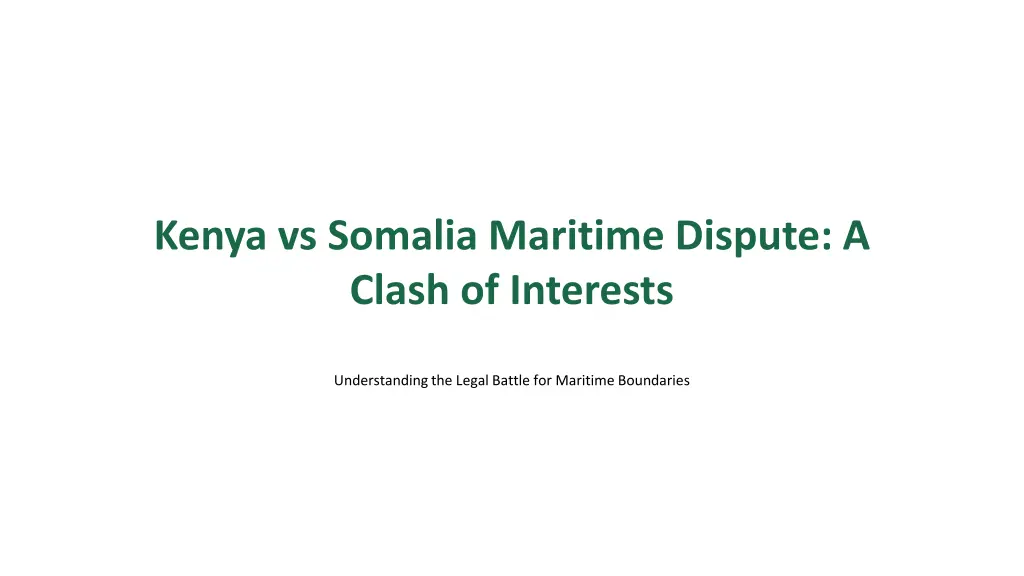
Understanding the Kenya-Somalia Maritime Dispute Legal Battle
Delve into the legal complexities of the Kenya-Somalia maritime dispute, initiated in 2014 and escalating tensions between the nations over maritime boundaries. Explore key legal arguments, implications for regional stability, and the significance of international law in resolving conflicts.
Download Presentation

Please find below an Image/Link to download the presentation.
The content on the website is provided AS IS for your information and personal use only. It may not be sold, licensed, or shared on other websites without obtaining consent from the author. If you encounter any issues during the download, it is possible that the publisher has removed the file from their server.
You are allowed to download the files provided on this website for personal or commercial use, subject to the condition that they are used lawfully. All files are the property of their respective owners.
The content on the website is provided AS IS for your information and personal use only. It may not be sold, licensed, or shared on other websites without obtaining consent from the author.
E N D
Presentation Transcript
Kenya vs Somalia Maritime Dispute: A Clash of Interests Understanding the Legal Battle for Maritime Boundaries
01 Introduction to the Dispute Table of Contents 02 Background and Initiation of the Case 03 Key Legal Arguments 04 Implications of the Dispute 05 Conclusion and Call to Action
1 Introduction to the Dispute In 2014, Somalia initiated a significant legal action against Kenya regarding maritime boundary delimitation, signaling a pivotal moment in African geopolitics. This dispute revolves around the maritime rights of both nations in the strategically important Indian Ocean, crucial for fishing and potential oil and gas reserves. Understanding this dispute requires delving into historical agreements and international maritime law that govern such boundaries. The case has broader implications for regional stability, international relations, and resource management in East Africa. This presentation aims to unravel the complexities of this maritime dispute and its implications.
2 Background and Initiation of the Case The roots of the dispute trace back to the colonial era, where maritime boundaries were not clearly defined. In 2009, Somalia laid claim to an extended maritime boundary, which Kenya contested, thus escalating tensions between the two nations. On August 28, 2014, Somalia formally filed its application at the International Court of Justice (ICJ). Kenya has continuously argued that the unilateral move by Somalia is unjust and undermines previously established agreements. This initiation marked an essential step towards legal resolution.
3 Key Legal Arguments Somalia claims a 200 nautical mile exclusive economic zone, according to the United Nations Convention on the Law of the Sea (UNCLOS). Kenya argues that the maritime border follows a line from the land boundary, as defined by historical treaties. International law plays a crucial role in determining the legitimacy of these claims based on established maritime practices. The ICJ's assessment is expected to rely heavily on both nations' adherence to international maritime law and historical context. Legal precedents set by similar disputes will also influence the proceedings and outcomes.
4 Implications of the Dispute The outcome has serious implications for maritime security, economic interests, and regional cooperation in East Africa. Access to fishing zones and potential undersea resources can alter the livelihoods and economies of both nations. Additionally, a ruling in favor of Somalia may encourage other nations to pursue similar claims, leading to increased regional tensions. Conversely, a ruling favoring Kenya could solidify its maritime authority and bolster its position in regional geopolitics. Understanding these implications highlights the importance of international law in resolving conflicts.
5 Conclusion and Call to Action The Kenya vs Somalia maritime dispute exemplifies the complexities of international law and geopolitics. As the case unfolds, it is essential for both nations to engage in dialogue and seek peaceful resolutions beyond the courtroom. The international community also has a role to play in facilitating negotiations and ensuring compliance with rulings. This case serves as a reminderof the need for clear maritime boundaries to avoid future conflicts. Thank you for exploring this vital issue about the Kenya vs Somalia maritime dispute.
